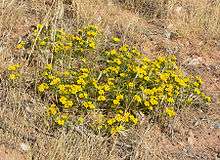Pectis papposa
| Pectis papposa | |
|---|---|
 | |
| var. papposa | |
| Scientific classification | |
| Kingdom: | Plantae |
| (unranked): | Angiosperms |
| (unranked): | Eudicots |
| (unranked): | Asterids |
| Order: | Asterales |
| Family: | Asteraceae |
| Genus: | Pectis |
| Species: | P. papposa |
| Binomial name | |
| Pectis papposa Harv. & A. Gray | |
Pectis papposa is species of flowering plant in the aster family, Asteraceae. It is native to North America, where it occurs in the southwestern United States as far east as Texas, and in northern Mexico. Common names include cinchweed,[1] common chinchweed, many-bristle chinchweed,[2] and many-bristle fetid-marigold.[3]
This is a host plant of the beet leafhopper.[4]
Uses
It can be found in Mexican markets sold as limoncillo. It is used in moderation to flavor meat.[5]
Among indigenous peoples
The Seri call the plant casol, casol heecto ("small casol"), casol ihasii tiipe ("fragrant casol"), and cacatajc ("what causes vomiting") and use it medicinally.[6] The Pima use a decoction of the plant or the dried plant itself as a laxative.[7] The Zuni people take an infusion of the whole plant as a carminative, and use an infusion of the flowers as eye drops for snowblindness. They also use the chewed flowers as perfume before dancing in ceremonies of "the secret fraternities".[8] The Havasupai parch and grind the seeds and use them to make mush and soup. They also dip the fresh plant in salt water and eat it with mush or cornmeal as a condiment.[9] The Pueblo use it as a spice.[10]
References
- ↑ Floristic Diversity and Discovery in the California Desert, James M. Andre, Fremontia, VOl. 42, No.1, January 2104, p.6 photo caption
- ↑ Pectis papposa. Germplasm Resources Information Network (GRIN).
- ↑ Pectis papposa. NatureServe. 2012.
- ↑ Kearny T. H., et al. Arizona Flora. University of California Press, Berkeley, CA. 1960.
- ↑ Soule, J. A. 1993. Systematics of Tagetes (Compositae). Ph.D. Dissertation. University of Texas at Austin. Austin, TX.
- ↑ Felger, R. S. and M. B. Moser. People of the Desert and Sea. University of Arizona Press, Tucson, AZ. 1985.
- ↑ Curtin, L. S. M. By the Prophet of the Earth. Sante Fe. San Vicente Foundation. 1949. p. 104.
- ↑ Stevenson, M. C. 1915. Ethnobotany of the Zuni Indians. SI-BAE Annual Report #30.
- ↑ Weber, S. A. and P. D. Seaman. Havasupai Habitat: A. F. Whiting's Ethnography of a Traditional Indian Culture. Tucson. The University of Arizona Press. 1985.
- ↑ Castetter, E. F. 1935. Ethnobiological Studies in the American Southwest I. Uncultivated Native Plants Used as Sources of Food. University of New Mexico Bulletin 4(1) 1-44. p. 38.
